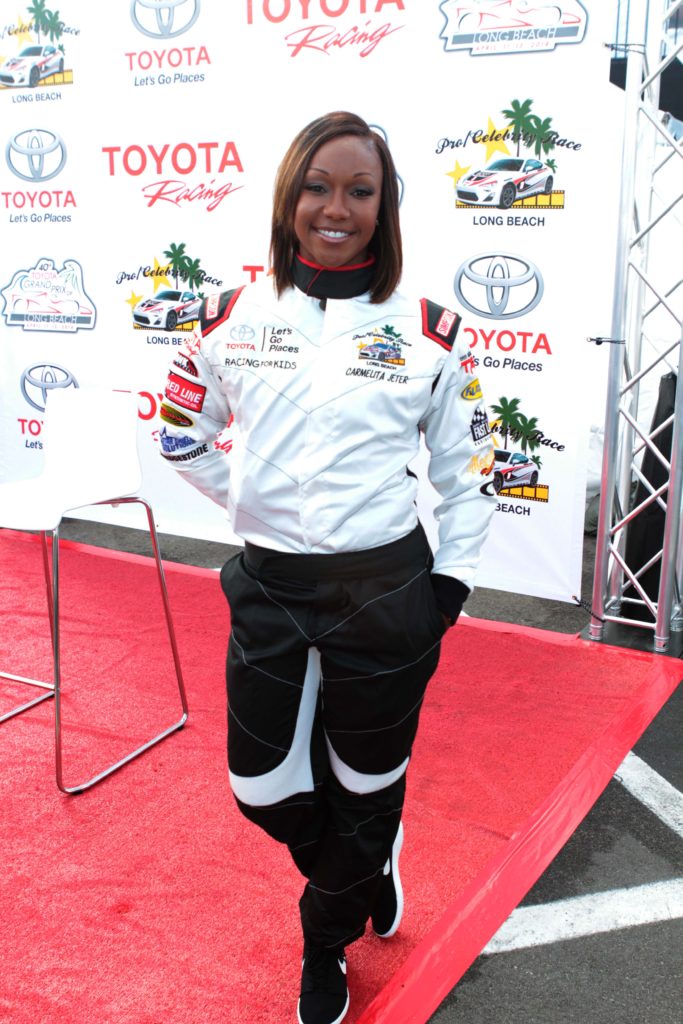USA track and field star Carmelita Jeter compares her struggles and ups and downs in track and field to the plight of the fictionary tale of Cinderella. Jeter’s story might be better. It certainly is more realistic and believable. All Cinderella had to do was fend off the hating habits of her wicked stepmother and two half-sisters, and get the right slipper placed on her feet.
After winning three medals (gold, silver and bronze) at the 2012 Olympics in London, Jeter can afford to get her own glass slipper. That doesn’t mean she has always been in a place to do that.
Jeter has had to overcome some real stuff to be where she is today. The odds of her becoming an elite, world class sprinter coming from a small college (California State University, Dominguez Hills), was remote at best. She’s has been beset by a whole slew of injuries throughout her decorated track career.
She has lost members of her family to cancer. On top of that, Jeter has had to deal with the close scrutiny and a lot of empty question marks spun by critics over some of her performances.
Cinderella’s worries look rather gentle in comparison to Jeter’s quest to be the “fastest woman alive.” Cinderella had mean-spirited hurdles thrown at her that she eventually overcame. Jeter’s cruelty has come in the form of debilitating injuries, including tearing up her left quadriceps at the U.S. Track and Field Championships last year.
In 2013, Jeter was taken off the track circuit for a while after suffering a similar injury to her right quadriceps. It’s been a tough go the past few years for the 2011 100-meter world champion. But Jeter is still standing tall.
“It’s been a rough couple of years,” Jeter said. “I’ve torn both quads; I had surgery on my right quad, so it definitely has not been all rosy. It’s kind of like a Cinderella story pretty much in a nutshell.”
A rebirth and another opportunity

If Jeter gets her wish, she will have a better story to tell than Cinderella by the time she officially call it quits. It may be a while before she does that. Cinderella made the trip to the ball one time. Jeter is aiming to make her second Team USA Olympic team.
Jeter is hoping that the 2016 Olympics in Rio de Janeiro, Brazil, will be her second trip to the big ball. The carriage that is going to take her there is the USA Track and Field Olympic Trials in July. Like the uncovering of the radiantly beauty of Cinderella, the unmasking of Jeter as America’s dominant female sprinter on track and field’s prime time stage could serve her well.
“I am older, and it is four years later, but I am still capable of making this team at the age of thirty-six,” Jeter said.
If anyone has the fortitude, the focus and the determination to make that happen, it’s Jeter.
Age is nothing but a number for the 5-foot-4, 135 pound granite-built Jeter. When you have a nickname like “The Jet” you don’t subject yourself to any type of limitations. Just ask the famed Jamaican sprint team that lost out to Jeter and the USA women’s 4 x 100 meter relay team at the 2016 Penn Relays.
Like she did in the 2012 Olympics, Jeter brought it home for the Americans with a little extra kick, as in kick-butt time. She didn’t look old. She wasn’t moving slow. Jeter did what she normally does, and that was blow by people.
“It was a nice win. It kind of starts off the season, and it helps with the camaraderie of the girls,” a modest Jeter said.
When boundaries come knocking on her door, Jeter is more likely to slap them in the face and tell them to go home. She is not swayed to conformity by what the naysayers have to say.
There’s been plenty of them. When she does well, it seems like the Jeter hateorade machine comes out of the closet. Jeter raised more than a couple of eyebrows when she flew by the radar gun in 2009 with a clocking of 10.64 seconds in the 100 meters, recording the second-fastest time ever by a woman.
Only the late great Florence Griffith Joyner (10.49) has run faster legally.
An Olympic dream fulfilled

Through all the doubts and slings and arrows pointed at her direction, Jeter, like Cinderella, moves past the negative vibes the same way when she run by people in the 100 meters: fast. That includes talk about age. Age should shouldn’t even be a subject if you left it up to Jeter. To her, it’s a nonfactor. Although there are always exceptions to the rule.
Jackie Joyner-Kersee was 36 when she won a bronze medal in the long jump event. The great American sprinter Evelyn Ashford picked up a gold medal at 35 when she ran one part of the USA 4 x 100 meter relay team that won first place at the Barcelona Summer Games in 1992.
Cinderella never had to worry about this age thing.
“I want to prove that I’m really tired of there always being this age limit,” said Jeter. “My thing is what do you say about the girl that didn’t make team, and she was 24? What do you say then? I definitely want to show that age is not a number, and that I am definitely still a contender at the age of thirty-six.”
Four years ago, Jeter salivated at reaching track and field’s pinnacle when she won her three medals at the 2012 Olympics. Jeter was a kid in a candy store, seeing her lifelong journey towards Olympic glory come to fruition.
Jeter’s exuberance when she crossed the finish line after anchoring the USA women’s 4 x 100 meter relay team to the gold medal win, was something to remember. It was a picture worth a thousands words…a fitting climax to what appeared to be the end to a storied track career.
“It was like a fairy tale story,” Jeter said. “I didn’t make the team in 2008; I made the team in the 100 (meters) and the 200 in 2012, and then I go into all three colors, gold, silver and bronze…all at the same time. It usually take people three Olympics to get all three colors, even more than that. I was very pleased with myself. I was very proud of myself. I accomplished something that they said hadn’t been done before, someone to get all three medals in one Olympics. I was just pleased with what I achieved.”
Jeter’s trifecta of medals is a worthy accomplishment for sure that should be acknowledged. That’s because Jeter joins a short list of top American female runners who have dominated the sprints with multiple medals at a single Olympic Games. Tennessee State’s legendary Wilma Rudolph kicked off this trend in 1960 when she became the first American woman to win three gold medals in track and field.
FloJo would be next in line when she stormed to four medals (three gold, one silver) at the 1988 Summer Games. Jeter and 2012 London Olympics teammate Allyson Felix (three gold medals) now keep company with Rudolph and FloJo. Pulling off the feat of winning three more medals in 2016 would simply put Jeter in track and field’s stratosphere.
Something still left in the tank

Father Time now seems to be Jeter’s biggest adversary.
By the realistic nature of track and field standards, Jeter should have moved on from her gold medal win in the 4 x 100 meter relay, the silver medal she earned in the 100 meters, and the bronze medal she picked up in the 200.
Complacency, age, burnout, career choices or apathy can derail an athlete’s ambition. That’s not the case with Jeter. She’s very hungry for another run at Olympic gold.
“If I decided to wake up tomorrow and I didn’t want to run track anymore, I can live with that,” Jeter said. “I’m very satisfied with what I accomplished in 2012. Am I finished? Am I tired? Am I done? No, I’m not. I did something amazing in London. I got three medals and a world record, and I did it at an age that everybody kept complaining about and saying was impossible. I accomplished so much. And now, it’s more so that I’m just not done.”
If anyone want proof that Jeter isn’t done they might want to check out and re-visit the world-record time of 40.82 seconds set by the U.S. women’s 4 x 100 meter relay team (Carmelita Jeter, Allyson Felix, Tianna Madison, Bianca Knight) at the 2012 Olympics. It was Jeter, at the age of 32, who bum-rushed the finish line for the Americans to shatter a 27-year-old mark with her blistering anchor leg.
It was Jeter, at the ripe age of 36, whom colleagues had the belief in to run the fourth and final leg on the U.S. (Carmelita Jeter, Tianna Bartoletta, Candyce McGrone, Kimberlyn Duncan) women’s 4 x 100 meter relay team at the Penn Relays as part of the USA vs. The World competition in April. It was Jeter who outdueled Jamaica’s Shelly-Anne Fraser-Pryce to lead the red, white and blue to victory.
“Being at the Penn Relays, being injured, I haven’t really run in two years, and the girls still wanted me on anchor,” Jeter said. “That made me feel really good because when you’ve been hurt, you’ve had surgery, you’re confident is a little low, you’re not running super fast times that you’re used…that made me feel good. [It was like] Okay, you guys still trust me, you guys still believe in me.”
Greatness comes at a cost. Greatness achieved is melded from sweat and sacrifice. Obstacles blocking that path only make the fruits of your labor more sweeter to enjoy once victory has been attained. One of the fruits that Jeter enjoys is having a sense of humor.
She likes to tell jokes. She likes to laugh. That’s a stark contrast to the more serious and tough exterior side of Jeter that people are used to seeing. The individuals who tormented Cinderella didn’t see her coming out of her timidity shell, either.
“I feel like I’m a comedian eighty-nine percent of the time,” Jeter said. “It just comes natural. It’s not like I’m trying to be Kevin Hart. I just enjoy a good time. I enjoy laughter. I love laughter.”

Dennis has covered and written about politics, crime, race, sports, and entertainment. Dennis currently covers the NFL, MLB, NBA, NCAA, and Olympic sports. Dennis is the editor of News4usonline.com and serves as the publisher of the Compton Bulletin newspaper. He earned a journalism degree from Howard University. Email Dennis at dfreeman@news4usonline.com
